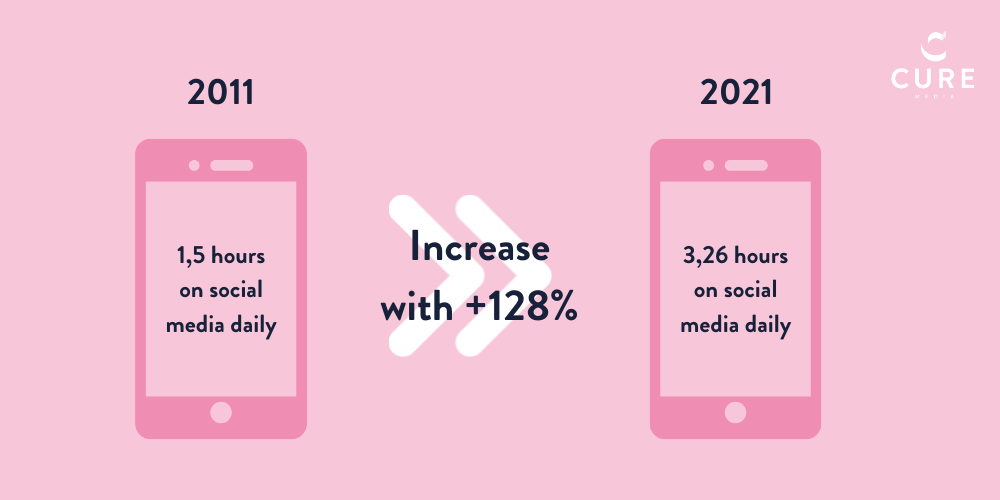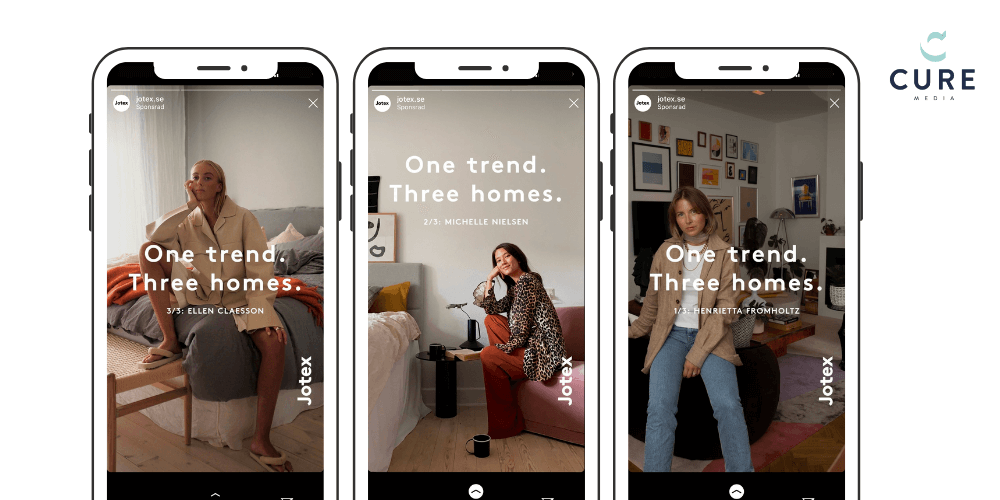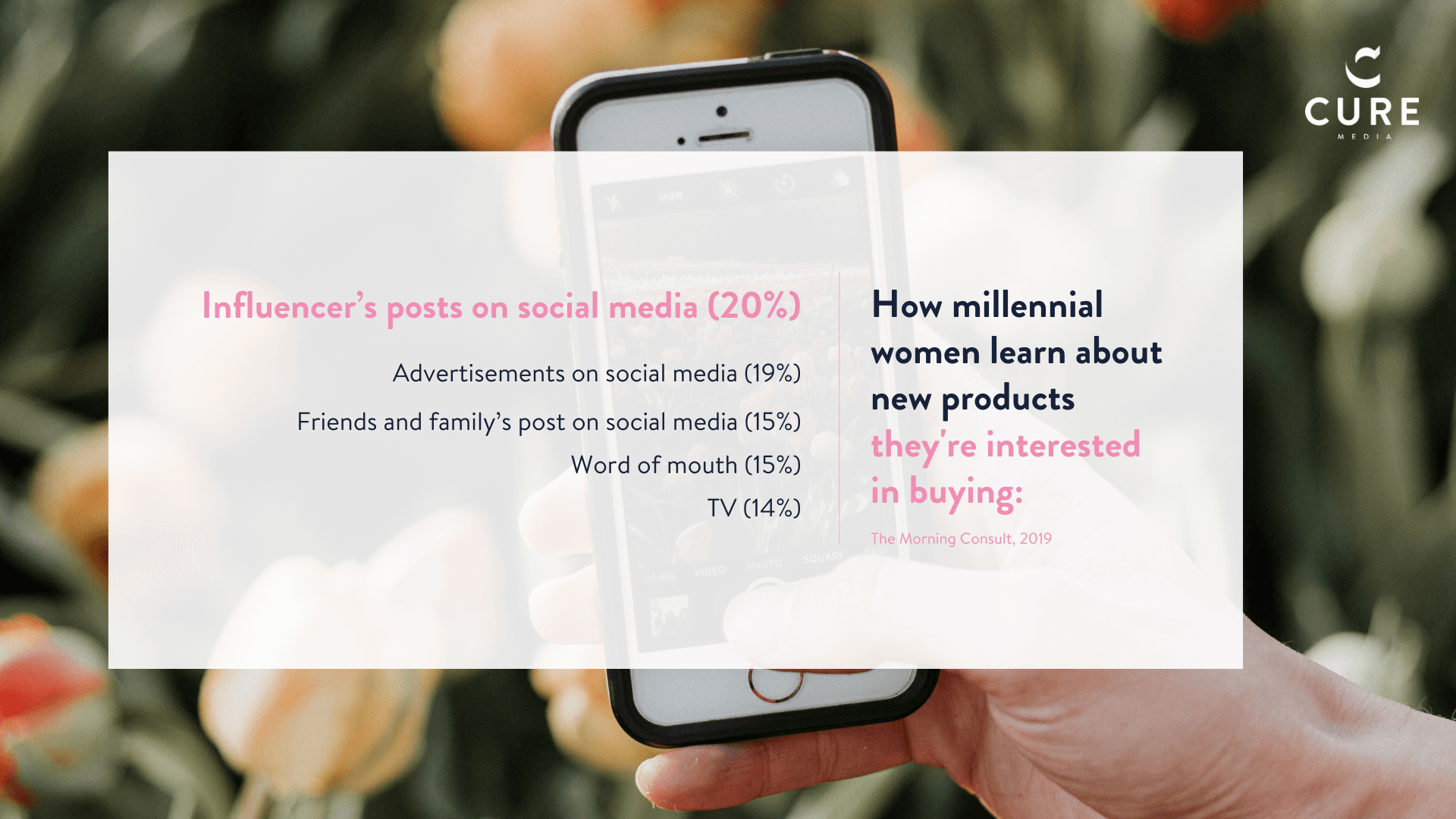This is an introduction to social media marketing tactics for all the marketers out there who know they want to work with social media but need some help navigating the social media jungle.
Prefer to listen? Tune in to our podcast episode about social media marketing tactics together with Emily Sun, Campaign Manager at Cure Media!
Today, when a social media presence is a need-to-have rather than nice-to-have, marketers are increasingly turning to social media channels as one of the most valuable ways to reach out to their audience. So why is it important for brands to have a social media strategy today?
Back in 2011, people spent an average of 1.5 hours on social media. Now, 10 years on, people spend an average of 3.26 hours on social media. That’s an increase of 128%, and it also means that if you want to meet today’s consumer where they’re spending their time, you need to be leveraging social media channels.

Social media has become the platform where we reach out and connect with other people, it’s where we fulfil our innate need to build relationships and it’s the prime place for brands to be when the people in those relationships are ready to explore or purchase products and services. This has, of course, gone further due to the increased social media usage during Covid.
On a fundamental level, there are two main classes of social media tactics and for the most part, you can group them under organic or paid media. First off, organic media encompasses everything that uses non-paid-for social media tools to share content and stories between users, brands and companies. Working with organic media is a great way for brands to outline who they are and what they’re about, to establish their voice, and build relationships with a loyal audience.
Paid social media, on the other hand, covers everything that has spend behind it. It is an avenue for brands to promote their content and communications through a variety of paid approaches, including everything from sponsored posts, display ads, retargeting and more. This is a gateway to expand reach and awareness and win more earned media, and this approach has become increasingly appealing to modern brands for its effectiveness in generating and engaging leads as users become more comfortable with the idea of buying directly from their feeds.
In practice, however, these paid and organic tactics complement each other really well and often work best when applied in tandem. Where the strong suit of organic media is its ability to build relationships and connections with loyal audiences, the benefit of paid is its ability to target and reach larger, untouched audiences and to drive leads and conversions for brands.
Below we will take a look at some of the different ways brands can work with social media tactics today.
Owned channels
Generally speaking, people that are following brands already have some level of interest, loyalty, history with the brand or purchase intent. This channel is key to building a community; it’s a space where brands can listen to their audience, be transparent and also interact with their customers at every stage of the customer journey.
Here’s an example from Gymshark’s Instagram account, where they frequently post user- and influencer generated content, tapping into their follower’s interests while at the same time showcasing their workout clothes.
Visa det här inlägget på Instagram
It is important for brands to work intimately with this channel to establish their brand identity, share inspiring content and build trust. And this last part, this building of trust, is super important because when brands build trust, consumers reward them. Consumers will be more likely to buy that brand first, more likely to stay loyal and will be more likely to advocate for and defend that brand.
Owned channels are also great for creating engaging content, such as live streaming, as this keeps users within your owned channels and therefore makes it easier to directly communicate with them.
Paid channels
Paid ads as executed by brands are a way for brands to promote their content through a variety of paid channels, whether it’s sponsored posts, display ads, ad placements or pop-ups. These approaches have strong targeting capabilities and are very agile to work with.
These options are typically low-cost for brands which makes them both accessible and appealing. They also have strong targeting capabilities and are more agile in adapting to rapid feature changes and developments on platforms. However, you need a lot of resources to effect a paid ad strategy and generate ongoing custom BGC in the long term.
Another paid social media tactic that brands can work with is dark posting. When brands work with dark posts, they are using targeted ads that are essentially unpublished page posts. These don’t appear on their own pages or on influencer pages, but they do appear as sponsored content in the feeds of existing and lookalike audiences they have identified. In this way, brands reach people’s feeds with highly targeted content, and they can do this while keeping their pages clean and maintaining a consistent brand voice and presence.
In the same vein, for potential customers that have viewed or placed an item in their basket when online shopping and do not complete their transactions, brands can leverage the paid social media tactic of retargeting.
Retargeting is a tactic that allows brands and companies to reach potential customers who did not convert right away. Retargeting keeps brands top-of-mind by reminding and re-engaging customers on different channels and at different touchpoints.
Since these consumers have previously visited the brand’s site, this method is often very effective in driving sales and increasing conversion rates. As part of the customer journey, retargeting plays an important part as visitors who are already familiar with the brand or product are more likely to convert.
Does influencer marketing have a place in the social media mix?
If a brand is working with an influencer marketing agency as part of the media mix, they will have access to bounds of influencer generated content that is reliably on brand, relatable and engaging. Brands can organically reshare these assets on their socials to diversify their content and shake things up from the status quo.
Here’s an example of an influencer post from one of our collaborations:
Visa det här inlägget på Instagram
As influencer voices continue to rapidly acquire and retain credibility across virtually all online demographics, many brands have cracked the code and have begun to amplify or recycle this content by using it on their paid social channels.
This can be an extremely effective approach, and some of the most successful fashion brands harness this strategy. This can take the form of running a multilayered campaign approach with a brand awareness campaign on paid social channels that is optimised on brand recognition using brand generated content, incorporating influencer marketing activations and collaborations, followed by implementing paid social ads using influencer generated content.
Below you can see an example of paid social ads using influencer generated content from our collaboration with Jotex.

For companies who are trying to reach Gen Z or millennials, this is particularly effective given that like much of the population, these groups respond to a peer recommendation, such as through an influencer ad, more than communication direct from the brand.
Many of today’s brands struggle to effectively leverage their social media channels to break through to these generations. Millennials and Gen Z are among today’s most proliferate social media users. They spend the most screen time on their phones and the most time on social platforms. As the first generation of digital natives, much of Gen Z and millennials are ad-weary, more attuned to targeted advertising and use ad-blockers much more than previous generations.
These groups in particular have a higher trust in influencers than in brands and respond better to authentic content and voices. In fact, this group values relatability over popularity to the extent that 63% of this group will trust what an influencer says about brands over what brands say about themselves. Therefore, brands that amplify influencer content and assets in their paid media boost their visibility and engagement and achieve more ROI than working with influencers and influencer-generated content alone.

Affiliate Marketing
Brands that have recognised the value of influencer marketing have also no doubt explored other organic or low-cost channels such as affiliate marketing. Affiliate marketing is a type of performance-based marketing where someone posts about a product they like on social media and earns a commission for the sales they drive for the brand. These sales are tracked via affiliate platforms such as LinkShare that brands partner with. An influencer working with affiliate links can work with multiple affiliate networks simultaneously, making it one of the most convenient ways for creators and influencers to generate income.
Likewise, for brands, this is a cost-efficient way to reach and convert their audience on social media. What brands should keep in mind, however, is that you have low control over who is going to post what and which audience you will be exposed to. There is no review process as you would have when working with influencers, so this can yield inconsistent results, especially if affiliates are promoting to the wrong demographics. Since this channel is so sales-focused, it is important to merge this tactic with one that is driving brand awareness and brand love as well. With newer features on social media platforms such as Instagram Shopping, the concept of social commerce makes it easier for affiliates to operate.
What is the most powerful social media marketing strategy?
The most powerful social media marketing strategy when it comes to influencer marketing is that when you collaborate with the right influencers, you have this opportunity to build a content-creating machine that churns on new content and assets on the reg and allows you to reach new and existing audiences in relevant markets. Brands that amplify influencer content and assets in their paid media boost their visibility and engagement and get more ROI than working with IGC alone.
If you have an always-on approach to influencer marketing as we recommend, you’ll get this new custom IGC created consistently throughout your marketing calendar. So not only will you have many good spillover effects from your collaborations with influencers on their channels, you get this spillover for your social media marketing too. And that’s why it’s a growing trend to recycle this content and have influencers appear in your paid strategy as well, especially since consumers are more likely to interact with ads that feature someone they recognise and trust.
If you achieve this holy trinity of influencer content, brand fit and paid ad spend, that’s a win for sure, but it demands a high level of trust between influencer and brand, a very good brand fit between the two and a nurtured relationship which takes both time and budget.
Final thoughts
The social media landscape in its various forms and iterations over the years has ensured a generation of digital marketers have been kept on their toes to remain relevant and stand out in an increasingly saturated online marketplace. Today’s fashion brands need to navigate a jungle of information and technologies in order to win a moment of facetime with their audience. At the crux of the digital, e-commerce age, it is more important than ever for brands to delve into the world of social media marketing to explore, understand and effectively leverage the trove of different tactics available to reach the modern consumer.


